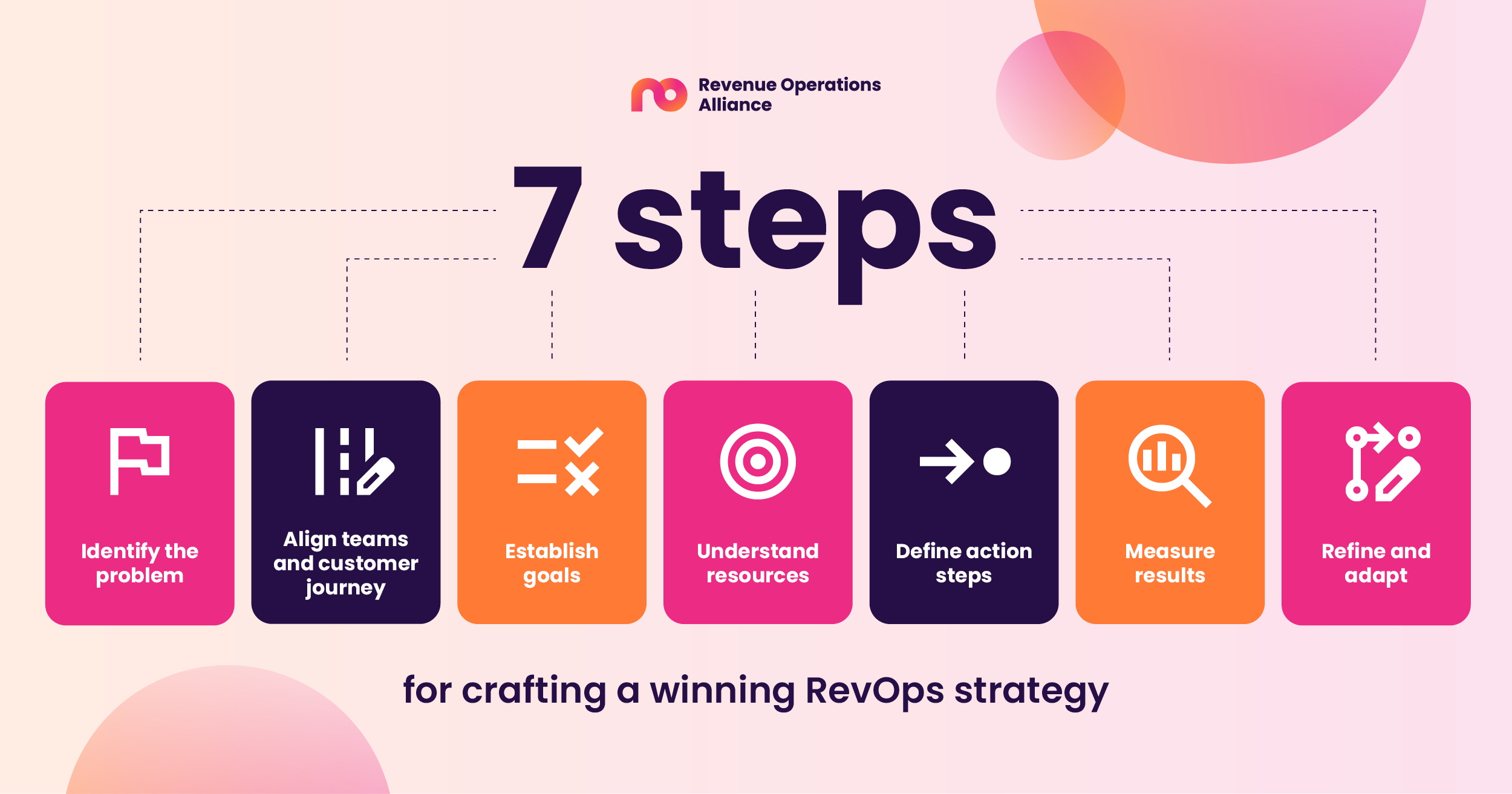Getting started on your revenue operation strategy can be challenging - especially if you’re starting from scratch.
This article will provide you with the steps (and confidence) you need to make your RevOps strategy shine. 🌟

The seven steps to success are:
- Identify the problem
- Align teams and customer journey
- Establish goals
- Understand resources
- Define action steps
- Measure results
- Refine and adapt
Identify the problem
In revenue operations (RevOps), you might be trying to solve a high-level issue like misaligned GTM teams or a lower-level problem such as clients dropping out of the sales cycle early. Either way, you need to fully understand the problem before you can find the solution.
A clear understanding of the problem is key to solving it effectively.
Once you dig a little deeper into the problem you may find that what you wanted to solve is just a symptom of an even bigger issue. This means you must re-jig your entire thought process around the issue - so it’s good to start there.
- Is there a significant delay in the handover process?
➡️ This may mean your handover process should be streamlined.
- Or maybe the leads aren’t relevant enough for sales to convert?
➡️ To solve this you may need to reevaluate your MQL definition.
Common challenges
Some other common challenges you may want your RevOps strategy to solve include:
- Aligning sales, marketing, and customer success teams
- Optimizing the sales funnel
- Improving revenue operations process efficiency
- Increasing revenue growth

Understand the history
Now you’ve identified the key problem you’d like your revenue operations strategy to solve, you might want to take a step back and understand the history of that problem within your organization.
This might include if your RevOps function has tried to solve this problem (or a similar one) before. And if they have, then understanding if it succeeded or failed and why, is key to solving your current problem.
Insight into why a previous solution failed can help you avoid those pitfalls when you try to solve this issue again. On the other hand, successful solutions for similar problems may guide you toward a trusted solution.
The history can also expand to your organization’s tendencies more broadly. Ask yourself:
- Does your organization usually take risks or play it safe?
- How quickly do new systems typically get approval?
- How long will it take to implement the change?
The answers to these questions may change your approach to the problem to better suit your organization.

Align teams and customer journey
Everything in RevOps comes back to aligning revenue teams, and strategy planning is no different. Revenue operations strategies normally span across sales, marketing, and customer success, so these functions must be united toward a common goal.
This will allow a coordinated effort towards solving the problem identified in the last step.
Management buy-in
That being said, alignment doesn’t always come easy - sometimes you need support from the big guns. Getting buy-in from management can allow teams to align more seamlessly as leadership is there to encourage those processes.
A Chief Revenue Officer (CRO) can be especially useful in aligning revenue-generating functions, as this is a major part of their executive-level role.
Want to learn more about the role of a CRO? Check out our guide! 👇

Become customer-centric
Once your GTM team is aligned, you should work with them to map out your ideal customer journey. You can use this to compare your goal to how your customer journey currently looks.
Mapping out this comparison allows you to identify the areas for improvement as well as allowing you to step into your customers’ shoes.
Having a customer-centric approach to your RevOps strategy helps you to provide a smooth customer journey, improving your customer experience. Which will lead to increased retention rates and recurring revenue over time.
Establish goals
To ensure you achieve your goal, you must define what exactly your goal is. Sure you want to solve a certain problem, but what does that look like in practice?
For example, to reduce churn, you might ask yourself:
- By how much?
- Over what time frame?
- Or simply, why?
Establishing a clear target with metrics to measure your progress keeps your team motivated and on track.

Understand resources
After establishing your goals, it might be time to assess what resources you have to execute these goals. Resources available to you will likely include team members, budget, and tools. Let’s assess each of these factors in turn.
Headcount
The number of team members on your GTM teams (and your RevOps team) and how full their schedules are will impact the scale of your planning. If all of your departments are small and super busy, you might struggle to make progress towards your goal.
To prioritize your RevOps strategy in larger teams, there may be scope to reassign some tasks. If you think your team may need an additional member to be successful, this may a be good time to consider hiring.

Budget
Budgeting for RevOps can be tricky. You must determine how much of your budget you’ll need to spend to achieve your goal. For example, you may want to hire a new sales rep or buy a new tool.
Understanding which of these requirements is essential and which are just nice-to-have is crucial for managing your RevOps budget effectively.
Tools
Look at your team’s workflows. Is there anything missing from your tech stack that is holding them back? Or maybe there are conflicting tools that slow down key processes.
Auditing your company’s tech stack for gaps and inefficiencies is crucial for planning your RevOps strategy.

Define action steps
The next step is to plan the action steps that’ll allow you to achieve your goals. These should be specific enough that they can easily be implemented into your revenue team’s workflow.
Each of these small steps should provide an impact towards solving your RevOps problem.
If you need to train your sales team on a new process - ensure you enlist the help of your sales enablement team to streamline the education process.
Automation is a huge component of a solid revenue operations strategy. You may wish to streamline manual processes to save time and reduce human error. By automating repetitive tasks, you can achieve both!
Check out our article to learn more about automation in RevOps.

Measure results
To ensure that your RevOps strategy is working how you expected, it’s important to measure the results of your approach. Otherwise, it’s tricky to know what worked and what didn’t.
To measure your impact effectively, revenue operations metrics should be set before implementing the new strategy. This will allow you to track how close you got to your goal after a certain period. It also helps to prevent ever-changing goalposts, which may demotivate your teams.
The metrics you track will differ depending on what project you’re working on but here are some that you might want to consider:
- Project ROI
- Conversion rate
- Sales pipeline velocity
- Customer churn rate
- Customer lifetime value

Refine and adapt
One revenue operations strategy won’t suffice forever - you’ll have to reassess and adapt to your organization’s changing business environment.
The key to a truly successful strategy is continuous improvement.
Use the data gathered in the last step to drive your decision-making process, and evaluate the success of your plan. This will allow you to keep the parts of your strategy that worked well and learn from the areas that didn’t perform.
Managing these ever-changing processes can be challenging but changing your strategy to stay ahead is key to maintaining long-term revenue growth.
Final thoughts
Creating a RevOps strategy from thin air can be challenging but hopefully, these steps will make the process less daunting.
Remember to understand the problem, your resources, and your goal. Gain stakeholder buy-in and don’t forget to measure the results of your strategy. Iterate your plan as needed to maintain revenue growth.
Want to connect with like-minded revenue professionals? Join our Slack community of 1000+ RevOps experts! 👇






